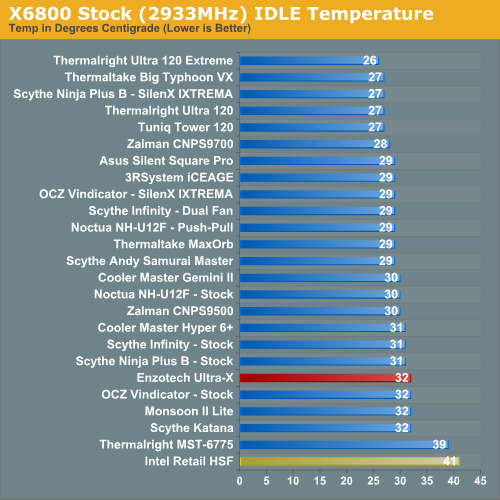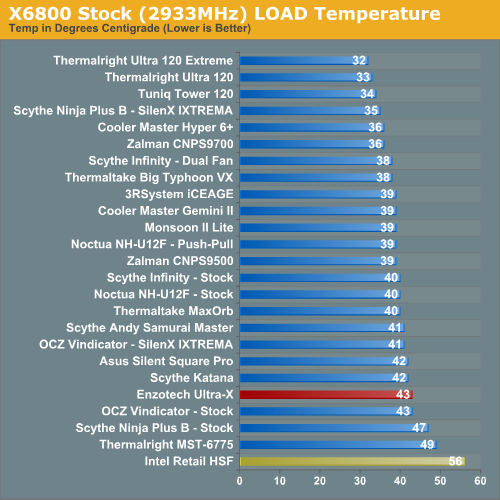Enzotech Ultra-X: If Looks Could Chill
by Wesley Fink on June 27, 2007 3:00 AM EST- Posted in
- Cases/Cooling/PSUs
Cooling at Stock Speed
Some users will never overclock their CPU, but they still want to run the coolest CPU temperatures possible to enhance stability and extend CPU life. The Enzotech Ultra-X comes with a high-quality slot-mounted rheostat coupled to a high-output Delta fan. Therefore we tested the Ultra-X cooler with the supplied fan and rheostat.

Where the very good Intel stock cooler keeps the X6800 at 41C at idle, the Ultra-X manages 32C. This is a significant improvement over the Intel stock cooler performance, but the results are average at best. The Thermalright coolers, at the top of our heatpipe tower performance charts, cool to 26C and 27C, and the Tuniq 120 maintains 27C.
It is more difficult to effectively simulate a computer being stressed by all of the conditions it might be exposed to in different operating environments. For most home users CPU power is most taxed with contemporary gaming. Therefore our stress test simulates playing a demanding game.
The Far Cry River demo is looped for 30 minutes and the CPU temperature is captured at 4 second intervals with the NVIDIA Monitor "logging" option. The highest temperature during the load test is then reported. Momentary spikes are ignored, as we report a sustained high-level temp that you would expect to find in this recording configuration. This test configuration roughly equates to an 80% CPU load test using Intel TAT.
Cooling efficiency of the Enzotech Ultra-X is then compared under load conditions at stock speed to the retail HSF and other recently tested CPU coolers.

The Ultra-X under load at stock speeds reached a maximum temperature of 43C with the included fan at its highest speed. This compares to the Thermalrights at 32C and 33C, the Tuniq at 34C, and the Cooler Master Hyper 6+ and Zalman 9700 at 36C. Stock load performance is below average among tested coolers, a pattern we have consistently seen with downward-blowing designs.
Some users will never overclock their CPU, but they still want to run the coolest CPU temperatures possible to enhance stability and extend CPU life. The Enzotech Ultra-X comes with a high-quality slot-mounted rheostat coupled to a high-output Delta fan. Therefore we tested the Ultra-X cooler with the supplied fan and rheostat.

Where the very good Intel stock cooler keeps the X6800 at 41C at idle, the Ultra-X manages 32C. This is a significant improvement over the Intel stock cooler performance, but the results are average at best. The Thermalright coolers, at the top of our heatpipe tower performance charts, cool to 26C and 27C, and the Tuniq 120 maintains 27C.
It is more difficult to effectively simulate a computer being stressed by all of the conditions it might be exposed to in different operating environments. For most home users CPU power is most taxed with contemporary gaming. Therefore our stress test simulates playing a demanding game.
The Far Cry River demo is looped for 30 minutes and the CPU temperature is captured at 4 second intervals with the NVIDIA Monitor "logging" option. The highest temperature during the load test is then reported. Momentary spikes are ignored, as we report a sustained high-level temp that you would expect to find in this recording configuration. This test configuration roughly equates to an 80% CPU load test using Intel TAT.
Cooling efficiency of the Enzotech Ultra-X is then compared under load conditions at stock speed to the retail HSF and other recently tested CPU coolers.

The Ultra-X under load at stock speeds reached a maximum temperature of 43C with the included fan at its highest speed. This compares to the Thermalrights at 32C and 33C, the Tuniq at 34C, and the Cooler Master Hyper 6+ and Zalman 9700 at 36C. Stock load performance is below average among tested coolers, a pattern we have consistently seen with downward-blowing designs.










33 Comments
View All Comments
GlassHouse69 - Friday, June 29, 2007 - link
This screams for a simple fan swap. Either a Nexus fan, a Yate loon, or a Papst 120. That with a front fan controller would make this a very decent cooler without the noise.mpelle4456 - Thursday, June 28, 2007 - link
I think it’s great that Anandtech is doing reviews on heat sinks, but I can’t get behind some of your methodology – i.e., the “highest stable overclocking” tests for heat sinks.There are so many, many variables at play when overclocking a computer, that unless every test was done with exactly the same components – the exact same CPU, the exact same motherboard, the exact same RAM, and so on – all the exact same hardware, with the exact same BIOS settings and software – then the test is not in any way valid.
Tests using the same model/brand CPU’s or RAM just don’t it – there are way too many variations between different CPU’s and steppings. An Opteron 170 CCB1E 0550VPMW might perform totally different to an Operton 170 CCBWE 0609FPAW. The same is true with RAM and other similar components.
The rest of the tests are more valuable – assuming that each of the 20 or so heat sinks were tested with the same model processors.
The best, most useful methodology I have seen was used by Joe Citarella over at Overclockers.com -- http://www.overclockers.com/articles373/p4sum.asp">http://www.overclockers.com/articles373/p4sum.asp
In their tests, they used a die simulator which put out a specific, precise amount of heat.
Their results are expressed as xx C/W (x degrees centigrade cooling per CPU watt – e.g., “To calculate what to expect for other CPUs, for every watt the CPU radiates, the heatsink will cool the core by the (C/W x watts) plus ambient temp. For example, at a fan inlet temp of 25 C, a C/W of 0.25 with a CPU radiating 50 watts means that the CPU temp will be 50 x 0.25 = 12.5 C over ambient temp, or 37.5 C.”
Unfortunately, it appears they discontinued their air cooling reviews some time ago.
Wesley Fink - Friday, June 29, 2007 - link
You are correct in stating highest overclock tests need all variables to remain the same. We DO use the excat same CPU, motherboard, RAM, BIOS settings. Hard Drive, and Software/OS image for all cooler overclocking tests.That is why we will retest a few representative coolers and start a new database when we make to the change to a new test bed. Ot os also why we are slow to change our test beds once they are established.
BigMacKing - Friday, June 29, 2007 - link
even in the same case?If it is, most of your cooler reviews will be worthless, unless users use the same case as you.
punko - Friday, June 29, 2007 - link
I'm not the sharpest stick in the umbrella stand, but I assume the case is standing normally, so the MB is vertical and the cooler is standing "sideways".With the down coolers, the heat pipes may disturbe the exhaust airflow. There are two possible arrangements at 90 degrees to each other. Would this affect things?
Note, also would apply to towers, which way do you point the fan? toward the exhaust vent?
For this cooler, there are 4 possible configurations, as the heatpipes are only on one side.
Is there any reason to suspect that the orientation of the cooler would have any difference?
Making sure the heated air is exhausted from the case is key, as is making sure you have a clear passage of cool air. any chance of recirculating the warm air will reduce cooling. the Towers have the advantage as the exhaust air would be moving the air not at the MB but directly at the exaust vent.
Just a thought
Tuffrabbit - Thursday, June 28, 2007 - link
Looks like the Thermalright Ultra 120 Extreme is going to be the winner for quite some time... But please keep bringing on all contenders ! Another great bout !magreen1 - Thursday, June 28, 2007 - link
I laughed out loudjebo - Thursday, June 28, 2007 - link
I wonder if the extra "bend" in heatpipes inherent in top-down coolers is preventing them from keeping up with the side-blowing coolers?Either way, each review solidifies my plan to pick up an Ultra 120 extreme once I make my quad-core upgrade :)
strikeback03 - Friday, June 29, 2007 - link
I'm wondering if it might be the extra length of the heatpipes before they get to the cooling fins. More heat would build up in the processor if it can't be moved away as efficiently.joetron2030 - Thursday, June 28, 2007 - link
First, I've really been enjoying these cooler tests. Very informative and I've been keeping track for my next build.One thing I would like to see, that I haven't seen so far, is a chart/graph that lists all of the tested coolers by weight. Considering one of the things mentioned in these tests is the weights of some of these coolers, it would be nice to be able to add that in as another point of comparison between these coolers. Unless, of course, their weights are all relatively close to one another.
Thanks for the consideration!